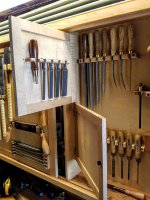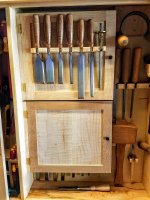HarveyWildes
Member
- Joined
- May 3, 2016
- Messages
- 984
Michael Kellough said:HarveyWildes said:Michael Kellough said:I’ve had to replace a few too many plugs when the chisel tore a bit off one side. This flush cut saw from Lee Valley is what I use now.
I've had the same problem when trying to cut off a plug that sticks out over about 1/8", but I've had issues with marring work if I get too close with a flush cut saw - even the ones with no set on the teeth. Generally what I do now is lay down a piece of card stock paper on the work and use the flush cut saw on top of that. There is still a bit of the plug sticking up, but now I can use a (very sharp) chisel, or chisel plane if the location is right, to pare rather than chop. I generally use a skew angle on the paring cut. I've had good results with that. I don't use a lot of traditional plugs, but I do use Miller Dowels for light structural work when I want to avoid screws, and for decoration. I use the same technique for getting flush through tenons and such.
You can save a minute by using Post-It notes instead of card stock. Then you’re within sanding range.
Yep - That's good if I'm sanding at a coarse enough grit, which is a lot of the time. I have managed to mar work using regular paper, but that's just me being careless. So I switched to card stock to make it idiot-proof. The Post-It note idea is great - holding paper in place under a flush-cut saw is a pain.






